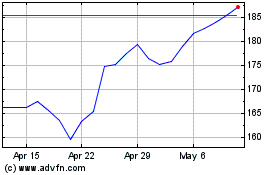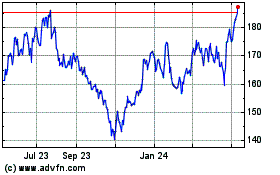Texas Instruments Inc. (TXN) reported an expected 17% increase
in fourth-quarter revenue as the chip maker benefited from strong
demand for mobile devices and analog and embedded products.
TI, which makes chips used in everything from cellphones to
industrial equipment, has seen a sharp rebound in demand after the
recession caused customers to virtually stop buying chips. While
there has been weaker consumer demand for personal computers and
televisions in recent months, and industrial demand is slowing to
more normal growth levels, TI is bullish any correction will be
"short and shallow."
"Our strong financial results for the fourth quarter reinforce
our view that the inventory-driven downturn that started in the
second half of 2010 is now mostly complete," Chairman and Chief
Executive Rich Templeton said.
Consumer demand for PCs bottomed in the fourth quarter and has
resumed growing, Chief Financial Officer Kevin March said in an
interview. TV demand, meanwhile, likely also bottomed.
"We didn't see growth resume in 4Q in TVs, but we were told by
customers to expect it to resume growth in the first quarter,"
March said. He said smartphones and automotive demand remain
strong, while industrial demand returned to more normal levels of
growth, as expected.
"Consumers are buying," March said.
For the first quarter, TI forecast a profit of 54 cents to 62
cents a share on revenue of $3.27 billion to $3.55 billion.
Analysts surveyed by Thomson Reuters expect 57 cents a share on
$3.33 billion in revenue.
The midpoint of guidance is "a little better than seasonal," TI
spokesman Ron Slaymaker said during a call with analysts, while the
fourth quarter was slightly weaker than normal seasonality. He said
the backlog going into the first quarter was higher than TI has
seen for that period in the past few years.
The company gained "significant" market share overall in the
quarter, as well as in TI's core businesses, March said.
Despite the strong results, shares slid 2.5% to $33.78 in
after-hours trading. The stock has jumped 50% since the end of
August and was up 2.2% during the regular session Monday.
"There were no real surprises, except the one-time gains from
the sale of assets," Gleacher & Co. analyst Doug Freedman. The
gain, combined with a tax benefit associated with the reinstatement
of the federal research and development tax credit, boosted
earnings by 14 cents a share.
"Numbers were slightly better than expected, but the stock has
been a strong performer along with the semiconductor sector of
late," he said.
TI has been increasing its focus on highly profitable analog and
embedded-application chips while winding down its business selling
mobile baseband chips after major cellphone makers shifted to a
multisupplier strategy. The company also has been supplying chips
to smartphones and tablets--including for power management and
processing with its OMAP platform.
March said TI has a lot of initial wins for OMAP in products
such as tablets, e-readers and navigation systems. Tablets
represent a $30-plus opportunity per device, he said, giving TI up
to $10 for analog chips per tablet, roughly $15 for the application
processor and $3 to $5 for connectivity such as Wi-Fi.
"We have a good portfolio that can capture those opportunities,"
he said. "There will be interesting ramps in 2011 in tablets."
TI has been using its ample cash to buy other companies, build
plants, and beef up its sales and engineering forces in China and
India. The company recently bought new manufacturing facilities in
Japan and China, and is expected to gain share by using RFAB, its
new 300-millimeter manufacturing facility for analog
semiconductors.
March said the three new factories contributed some revenue in
the fourth quarter and that utilization rates should increase
steadily through 2011.
"We feel completely comfortable with the headroom that we have
on our capacity now that will allow us to grow quite aggressively
if that's what the market wants to do," TI said on the call.
Still, bringing the factories on line hurt margins in the fourth
quarter.
TI reported fourth-quarter profit of $942 million, or 78 cents a
share, up from $655 million, or 52 cents, a year earlier.
Fourth-quarter earnings were 64 cents a share, excluding a gain
from the sale of certain assets to Intel Corp. (INTC) and a tax
benefit associated with the reinstatement of the federal research
and development tax credit.
Revenue jumped 17% to $3.53 billion.
In December, TI narrowed its fourth-quarter per-share earnings
guidance to 61 cents to 65 cents, excluding the gain, and $3.43
billion to $3.57 billion of revenue--keeping the midpoint of both
forecasts unchanged.
Gross margin edged up to 53% from 52.9%.
Sales of analog chips, which made up 43% of total revenue,
climbed 20%, while earnings rose 27%.
The company said orders fell 4% from a year earlier and 9% from
the prior quarter, which March attributed to shorter lead times for
customers to get the products. Orders were "very weak" in October,
Slaymaker said on the call, but were "appreciatively higher" in
November and December. The company said lead times largely are back
to normal.
-By Shara Tibken, Dow Jones Newswires; 212-416-2189;
shara.tibken@dowjones.com
Texas Instruments (NASDAQ:TXN)
Historical Stock Chart
From Jun 2024 to Jul 2024

Texas Instruments (NASDAQ:TXN)
Historical Stock Chart
From Jul 2023 to Jul 2024
